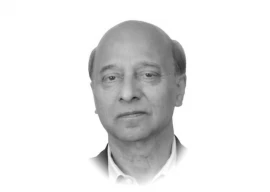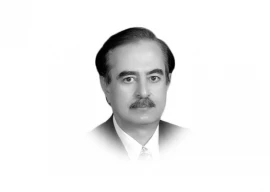
Over the decades, I have kept visiting my alma mater with fondness. In recent years, the Bhagsar School has transformed. It has been upgraded to the high school level, and there is a girls’ high school in the village as well. It can now be considered a modern school by any yardstick one may apply. It has a proper building, labs, equipment and teachers, though not in numbers the school requires. It has well-maintained lawns, green spaces, trees, flowers and even climbing ivies over parts of the building. Unlike in our days, students sit on benches and against desks. They dress in a uniform that has changed during the past five years, from the awami libas to trousers and shirt. One ‘revolutionary’ change in the education system of Punjab in recent years has been in the area of appointment of female teachers in the boys’ high schools: Bhagsar has two of them.
There are two remarkable changes one cannot miss, and I think that is happening throughout the entire province. The first is the relative increase in enrollment. This high school has more than 500 students and attendance is recorded daily on the blackboard on a wall of a classroom. It read 94 per cent for the day I visited. Because of poverty perhaps, this public school is the only option for the local population. The parents and the local community take interest in the development of the school and in every event the school conducts. Independence Day brings the entire community on the lawns of the school to celebrate, listen to speeches and eat food together, which is prepared with voluntary contributions. The second important change is in technology. There is a well-equipped computer lab for students and two more computers for office use.
The terror threat has greatly affected the school system in Punjab. Schools with student population of more than 500, including this one, are required to have closed-circuit cameras with a monitor on the table of the headmaster. The boundary walls have been raised high with razor-wires on the top. It seems the terror threat has cost a huge some of money province-wise to deal with the situation.
It is hard to comment on the quality of education, but going by the results, the school has a pass rate of over 90 per cent in the matriculation examination. There are three important lessons here. First, the leadership of a school makes the difference in maintaining discipline, implementing policies and generating resources. Second, the interest and engagement of the community with the affairs of a public school generates a sense of pride, ownership and participation, and ultimately, a form of local accountability. Finally, reforms with benchmarks and resources make all the difference.
There is no alternative to having a quality public school system for the majority of the population. Let us own our public schools, develop them and provide for the missing facilities.
Published in The Express Tribune, October 14th, 2015.
Like Opinion & Editorial on Facebook, follow @ETOpEd on Twitter to receive all updates on all our daily pieces.

1722586547-0/Untitled-design-(73)1722586547-0-165x106.webp)


1732326457-0/prime-(1)1732326457-0-165x106.webp)








COMMENTS (1)
Comments are moderated and generally will be posted if they are on-topic and not abusive.
For more information, please see our Comments FAQ